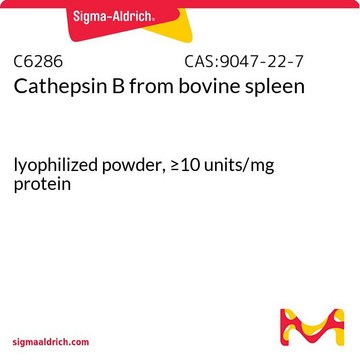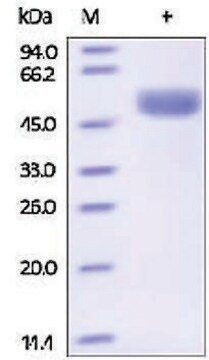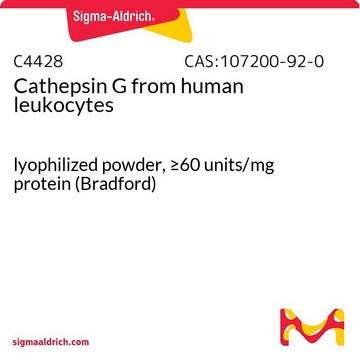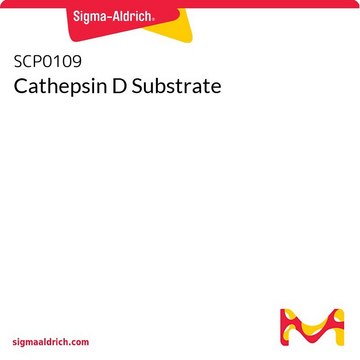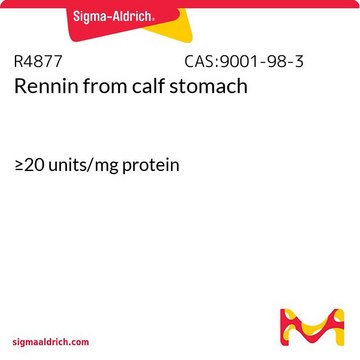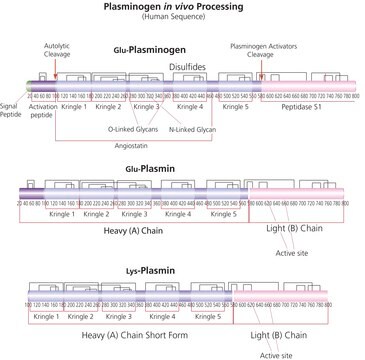C3138
Cathepsin D from bovine spleen
lyophilized powder, ≥2.0 units/mg protein
Sinónimos:
CTSD
Iniciar sesiónpara Ver la Fijación de precios por contrato y de la organización
About This Item
Número de CAS:
MDL number:
UNSPSC Code:
12352204
NACRES:
NA.32
Productos recomendados
biological source
bovine spleen
assay
10—70% protein (biuret)
form
lyophilized powder
specific activity
≥2.0 units/mg protein
mol wt
~45 kDa
manufacturer/tradename
Sigma-Aldrich
technique(s)
activity assay: suitable
color
dark brown
suitability
suitable for molecular biology
UniProt accession no.
application(s)
life science and biopharma
storage temp.
−20°C
Gene Information
cow ... CTSD(282883)
¿Está buscando productos similares? Visita Guía de comparación de productos
Categorías relacionadas
General description
Research area: Cell Signaling
Cathepsin D is a soluble endosomal-lysosomal aspartic protease and is synthesized in the rough endoplasmic reticulum as preprocathepsin D. It is encoded by the CTSD gene located in the 11p15.5 region.
Cathepsin D is a soluble endosomal-lysosomal aspartic protease and is synthesized in the rough endoplasmic reticulum as preprocathepsin D. It is encoded by the CTSD gene located in the 11p15.5 region.
Application
Cathepsin D from bovine spleen has been used:
- in in vitro dose-dependent fluorometric activity assays.
- in in vitro myelin oligodendrocyte glycoprotein (MOG) digestion to study the uptake of malondialdehyde (MDA)-modified MOG and its implications in central nervous system autoimmunity.
- for enzymatic digestion of the proteoglycan moiety of the articular cartilage in order to determine its dynamic elastic modulus at two different levels of tissue organization.
- in cathepsin D activity assay.
Biochem/physiol Actions
Cathepsin D is an endosomal-lysosomal aspartic protease implicated in breast cancer metastasis and Alzheimer′s disease. Lysosomal release of cathepsin D has been found to precede cytochrome c release and loss of membrane potential in apoptotic human foreskin fibroblasts. Cathepsin D levels in PC12 cells increase 12 to 24 hours after apoptosis is induced.
Endosomal-lysosomal aspartic protease implicated in breast cancer metastasis and Alzheimer′s disease. Lysosomal release of cathepsin D has been found to precede cytochrome c release and loss of membrane potential in apoptotic human foreskin fibroblasts.
Unit Definition
One unit will produce an increase in A280 of 1.0 per min per mL at pH 3.0 at 37 °C measured as TCA-soluble products using hemoglobin as substrate (1 cm light path).
Physical form
Lyophilized powder containing citrate buffer salts
inhibitor
Referencia del producto
Descripción
Precios
related product
Storage Class
11 - Combustible Solids
wgk_germany
WGK 3
flash_point_f
Not applicable
flash_point_c
Not applicable
Elija entre una de las versiones más recientes:
¿Ya tiene este producto?
Encuentre la documentación para los productos que ha comprado recientemente en la Biblioteca de documentos.
Los clientes también vieron
Xiaoli Feng et al.
Experimental hematology, 42(3), 172-182 (2013-12-03)
The small molecule b-AP15 is a novel inhibitor of proteasome deubiquitination. Recent studies have shown that b-AP15 displays antitumor activity in several preclinical, solid tumor models. In this study, we show that b-AP15 triggers time- and dose-dependent apoptosis of the
Michelle E Edye et al.
The Journal of biological chemistry, 288(42), 30485-30494 (2013-09-12)
The proinflammatory cytokine IL-1β is a key mediator of inflammatory responses that contribute to and exacerbate brain injury. IL-1β is synthesized by microglia in the brain as an inactive precursor (pro-IL-1β). Cleavage of pro-IL-1β to a mature form is stimulated
Gabriel C Baltazar et al.
PloS one, 7(12), e49635-e49635 (2012-12-29)
Lysosomal enzymes function optimally in acidic environments, and elevation of lysosomal pH can impede their ability to degrade material delivered to lysosomes through autophagy or phagocytosis. We hypothesize that abnormal lysosomal pH is a key aspect in diseases of accumulation
Maria Pernemalm et al.
Journal of proteome research, 12(9), 3934-3943 (2013-08-02)
In this study, we have analyzed human primary lung adenocarcinoma tumors using global mass spectrometry to elucidate the biological mechanisms behind relapse post surgery. In total, we identified over 3000 proteins with high confidence. Supervised multivariate analysis was used to
Jason S King et al.
Molecular biology of the cell, 24(17), 2714-2726 (2013-07-26)
Wiskott-Aldrich syndrome protein and SCAR homologue (WASH) is an important regulator of vesicle trafficking. By generating actin on the surface of intracellular vesicles, WASH is able to directly regulate endosomal sorting and maturation. We report that, in Dictyostelium, WASH is
Nuestro equipo de científicos tiene experiencia en todas las áreas de investigación: Ciencias de la vida, Ciencia de los materiales, Síntesis química, Cromatografía, Analítica y muchas otras.
Póngase en contacto con el Servicio técnico